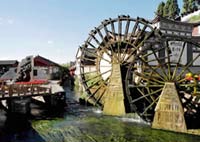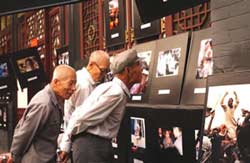
Of China's 29 listed world heritage sites, two ancient cities are well known for their preservation of unique historical remains and cultural relics. One is the old city of Lijiang in Yunnan Province and the other is the old city of Pingyao in Shanxi Province.
Lijiang
With a history of over 800 years, Lijiang is unique for the native Dongba culture and traditional Naxi architecture, streetscapes, canals and waterways preserved by the local Naxi people. Some experts believe that what makes the old city of Lijiang attractive is that it is a city that lives and breathes, and not only a palace or museum just for exhibition.
The city was described by the World Heritage Committee as having "retained an historic townscape of high quality and authenticity. Its architecture is noteworthy for the blending of elements from several cultures that have come together over many centuries."
Since it was inscribed on the World Heritage List in December 1997, the local government has taken more responsibility for the development and protection of the old city. But development and protection seem to be a contradiction in terms. To develop the city means more modern buildings, and companies will move there and more tourists will be attracted to bring about economic returns. However, the business atmosphere will devour the ancient culture, and the overpopulation led by boosted tourism will make the old city overburdened. All these will finally destroy the world heritage site.
So how could the two be combined -- introducing modern development into the old city, while preserving the historic remains of the city? The answer it seems is to "protect the old city and develop a new city."
The local government has started the construction of a new city named "Xianghe Licheng," which means peaceful and beautiful city. This project is to be constructed with private capital. The total investment is estimated at 6 billion yuan ($725 million). According to He Lianghui, Secretary of the Party Committee of the Old City District of Lijiang, the new city will be built in the same architectural style of the old city, Lijiang. Covering an area of over 330 hectares, the new city will help accommodate residents and enterprises relocated from the old city, and part of the new city will be used to attract investment from home and abroad in projects for promoting the local economy.
To better protect the old city, the local government also invested in repairing and upgrading the sewage and drainage networks, the electrical power grid, telecommunications facilities and the road network both in and around the old city proper.
Besides, to minimize the impact of modern business activities on the ancient culture of Lijiang, shops in the old city proper have been rearranged; those with obvious modern business characteristics have been moved out of the old city area. Cement block multi-story buildings that are out of tune with the local architectures have been demolished.
Through hard efforts of combining the protection and development, the old city of Lijiang has kept its unique charm. Richard Engelhardt, Regional Advisor for Culture in Asia and the Pacific of the United Nations Educational, Scientific and Cultural Organization (UNESCO), who visits Lijiang several times almost every year, said that Lijiang's administration of its old city proper has been effective, and its historical authenticity has been given high attention.
Now the old city of Lijiang has been chosen by international tourism authorities as "one of the 10 most attractive cities in China."
Pingyao
Similar to Lijiang, the old city of Pingyao is also struggling to balance progress and preservation. Built over 2,000 years ago as a military base, Pingyao was rebuilt in 1370. Today Pingyao remains much of its architecture typical of that time. According to the World Heritage Committee of UNESCO, "The ancient city of Pingyao is an outstanding example of a Han Chinese city of the Ming (1368-1644) and Qing (1644-1911) dynasties that has retained all its features to an exceptional degree, and in doing so provides a remarkable picture of cultural, social, economic, and religious development during one of the most seminal periods of Chinese history."
Since Pingyao was added to the World Heritage List in 1997, the old city has attracted lots of tourists as well as business people. And the population burden began to attract the attention of more and more people.
Covering an area of 2.25 square km, the old city of Pingyao now has about 40,000 residents. But experts believe that the proper size of population for Pingyao should be no more than 22,000.
Actually the local government has planned to move all of the enterprises and institutions out of the old city, and reduce half of the total number of residents to about 25,000 before 2005. Local government authorities have taken the lead to move out of the old city, which were followed by hospitals and schools. But when the relocation project comes to the ordinary residents, it becomes much difficult, largely because of the lack of money.
Most of the Pingyao residents cannot afford to move out of the old city to a new residential area. Duan Ruosheng, an official with the Pingyao Urban and Rural Construction Bureau, said that at present the price for houses outside the old city of Pingyao is about 1,100 yuan ($133) per square meter, and to buy a 100-square-meter house needs over 100,000 yuan ($12,077). That's almost impossible for most of the residents in Pingyao, where the salary for a low-ranking government official is about 900 yuan ($108.7) per month, said Duan.

And the local government can only pursuade people to move out, but cannot force them to do so, as the government now has no money to compensate for their relocation, said Duan.
According to Li Hongzheng, Director of the Tourism Bureau of Pingyao, preserving the old city of Pingyao and developing a new one requires 1 billion yuan ($120.8 million). In the past, the financial revenue of Pingyao was about 40 million yuan ($4.8 million), which exceeded 200 million yuan ($24.2 million) in 2003. "Even though," said Li Hongzheng, "the old city of Pingyao still falls behind when compared to the old city of Lijiang in Yunnan Province which has also been listed as a world heritage site."
Statistics show that the annual ticket income in Pingyao is 20 million yuan ($2.4 million), while that in Lijiang is 200 million yuan ($24 million). There are only two star-level hotels in Pingyao, but over 76 in Lijiang.
Protecting the world heritage sites and leaving the world with a picture of history, both the two old cities have a long way to go.
(Beijing Review June 25, 2004)
|

